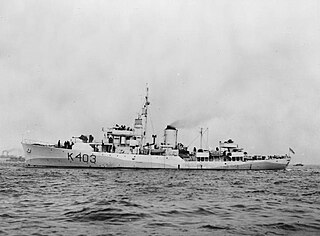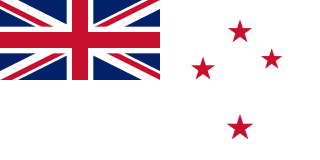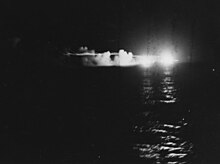
HMNZS Achilles was a Leander-class light cruiser, the second of five in the class. She served in the Royal New Zealand Navy in the Second World War. She was launched in 1931 for the Royal Navy, loaned to New Zealand in 1936 and transferred to the new Royal New Zealand Navy in 1941. She became famous for her part in the Battle of the River Plate, alongside HMS Ajax and HMS Exeter and notable for being the first Royal Navy cruiser to have fire control radar, with the installation of the New Zealand-made SS1 fire-control radar in June 1940.

The Royal New Zealand Navy is the maritime arm of the New Zealand Defence Force. The fleet currently consists of nine ships. The Navy had its origins in the Naval Defence Act 1913, and the subsequent acquisition of the cruiser HMS Philomel, which by 1921 had been moored in Auckland as a training ship. A slow buildup occurred during the interwar period, and then in December 1939 HMS Achilles fought alongside two other Royal Navy cruisers at the Battle of the River Plate against the German ship, Graf Spee.

The British Pacific Fleet (BPF) was a Royal Navy formation that saw action against Japan during the Second World War. It was formed from aircraft carriers, other surface warships, submarines and supply vessels of the RN and British Commonwealth navies in November 1944.

HMNZS Leander was a light cruiser which served with the Royal New Zealand Navy during World War II. She was the lead ship of a class of light ships, the Leander-class light cruiser and was initially named HMS Leander.

HMNZS Wellington was a Leander-class frigate of the Royal Navy and the Royal New Zealand Navy (RNZN). Originally commissioned in 1969 for the Royal Navy as HMS Bacchante, she joined the RNZN in 1982. She was decommissioned in 1999 and sunk in 2005.

HMS Black Prince was a Dido-class light cruiser of the Royal Navy, of the Bellona subgroup. The cruiser was commissioned in 1943, and served during World War II on the Arctic convoys, during the Normandy landings, and as part of the British Pacific Fleet. In 1946, the cruiser was loaned to the Royal New Zealand Navy, becoming HMNZS Black Prince. The cruiser was docked for modernisation in 1947, but in April, her sailors walked off the ship as part of a series of mutinies in the RNZN. The shortage of manpower resulting from these mutinies meant that the modernisation had to be cancelled, and Black Prince was placed in reserve until 1953. She returned to service after refitting with simplified secondary armament with a single quad "pom pom" in Q position and eight Mk3 40mm Bofors guns. The ship was decommissioned again two years later, and returned to the Royal Navy in 1961. Black Prince did not re-enter service, and was towed from Auckland to Osaka for scrapping in 1962.

Operation Inmate was an attack by the British Pacific Fleet against Japanese positions on Truk Atoll in the central Pacific Ocean during the Second World War. The attacks against the isolated islands on 14 and 15 June 1945 were conducted to provide combat experience for the aircraft carrier HMS Implacable and several of the fleet's cruisers and destroyers ahead of their involvement in more demanding operations off the Japanese home islands.

HMS Royalist was a Bellona-class light cruiser of the Royal Navy (RN) and Royal New Zealand Navy (RNZN) during the Second World War and early Cold War.

HMS Gambia was a Fiji-class light cruiser of the Royal Navy. She was in the service of the Royal New Zealand Navy (RNZN) as HMNZS Gambia from 1943 to 1946. She was named after the then Crown colony of the Gambia, and has been the only ship of the Royal Navy to bear the name.

HMNZS Waikato (F55) was a Leander Batch 2TA frigate of the Royal New Zealand Navy (RNZN). She was one of two Leanders built for the RNZN, the other being the Batch 3 HMNZS Canterbury. These two New Zealand ships relieved British ships of the Armilla patrol during the Falklands conflict, freeing British ships for deployment.

HMNZS Arbutus was a modified Flower-class corvette of the Royal New Zealand Navy (RNZN). Built for the Royal Navy as HMS Arbutus, the corvette was transferred to the RNZN on completion in 1944, and operated in the British Pacific Fleet during the final year of World War II. In April 1947, Arbutus was one of the units involved in a mutiny over poor pay and working conditions. She was decommissioned in 1948 and broken up for scrap in 1951.

HMNZS Endeavour (A11) was a fleet oiler for the Royal New Zealand Navy. She was named after James Cook's Bark Endeavour and the third ship in the RNZN to carry that name, though if continuity with the Royal Navy ships of the name HMS Endeavour is considered, she is the twelfth. The previous two ships of the RNZN were Antarctic research support vessels. Endeavour was built in South Korea to a commercial design and commissioned on 8 April 1988, and decommissioned on 15 December 2017.

HMNZS Canterbury (F421) was one of two broad beam Leander-class frigates operated by the Royal New Zealand Navy (RNZN) from 1971 to 2005. She was built in Scotland and launched in 1970. Commissioned in 1971, Canterbury saw operational service in much of Australasia and other regions like the Persian Gulf. She undertook operations such as supporting UN sanctions against Iraq and peace-keeping in East Timor. With her sister ship HMNZS Waikato she relieved the Royal Navy frigate HMS Amazon in the Indian Ocean during the Falklands War. Early in HMNZS Canterbury's career, in 1973, she relieved the frigate HMNZS Otago, as part of a unique, Anzac, naval operation or exercise at Moruroa during anti-nuclear protests, supported by a large RAN tanker, providing fuel and a large platform for Australian media. This was due to F 421 being a more modern RNZN frigate, with then current Rn surveillance radar and ESM and a more effectively insulated frigate from nuclear fallout, with the Improved Broad Beam Leander steam plant, for example, being remote controlled and capable of unmanned operation and therefore the ship provided a more effective sealed citadel for operations in areas of nuclear explosions.

The New Zealand Division of the Royal Navy also known as the New Zealand Station was formed in 1921 and remained in existence until 1941. It was the precursor to the Royal New Zealand Navy. Originally, the Royal Navy was solely responsible for the naval security of New Zealand. The passing of the Naval Defence Act 1913 created the New Zealand Naval Forces as a separate division within the Royal Navy.

HMNZS Philomel is the main administrative base of the Royal New Zealand Navy. Originally a training base on board the cruiser from which it takes its name, it is part of the Devonport Naval Base on the North Shore of Auckland, New Zealand.

The Royal New Zealand Naval Volunteer Reserve (RNZNVR) is the volunteer reserve force of the Royal New Zealand Navy (RNZN).
During April 1947, the Royal New Zealand Navy (RNZN) experienced a series of non-violent mutinies amongst the enlisted sailors of four ships and two shore bases. Over 20% of the RNZN's enlisted personnel were punished or discharged for their involvement. The main cause was the poor rates of pay compared to the rest of the New Zealand Defence Force and equivalent civilian wages, exacerbated by the release of a long overdue government review which failed to address the issue. Sailors saw the new pay rates as still inferior to the other branches of the military, with the increases being consumed by taxes, inflation, and the cancellation of allowances and benefits. The poor living and working conditions aboard RNZN ships was another issue, compounded by sailors having no effective way to make dissatisfaction known to the higher ranks. Dissatisfaction with peacetime duties and opportunities also contributed, with many sailors locked into enlistment periods of up to 12 years, and demobilisation efforts prioritising those enlisted specifically for the duration of World War II.
Commodore George Raymond Davis-Goff was a senior officer in the Royal New Zealand Navy (RNZN).

The Torpedo Bay Navy Museum is the official museum of the Royal New Zealand Navy. It opened in 2010, to replace an earlier naval museum. The museum is in Devonport, Auckland.

The Royal New Zealand Navy Band is the musical arm of the Royal New Zealand Navy, serving its musical needs from its headquarters at HMNZS Philomel on Devonport Naval Base, North Shore City, Auckland.





















